Why Orthodontics
For most people, achieving a healthy, beautiful smile is the reason for receiving orthodontic care. If the look and arrangement of teeth do not particularly make you happy and you’re self-conscious about your smile, correcting your concerns with braces will greatly improve the way you look and feel.
Improving the arrangement and positions of your teeth with braces will make your teeth easier to clean and hence less prone to cavities and gum problems. Better positioning of your teeth will also make them less prone to external and internal injuries. Good set of teeth makes sure that you have good chewing ability, healthy jaw joint function and balanced facial musculature.
When your braces treatment is done, you will have the smile you’ve always dreamt of and the confidence to show it off. We also want you to feel comfortable and confident throughout your entire orthodontic experience, and our practice is dedicated to making sure that you receive the quality care you deserve.
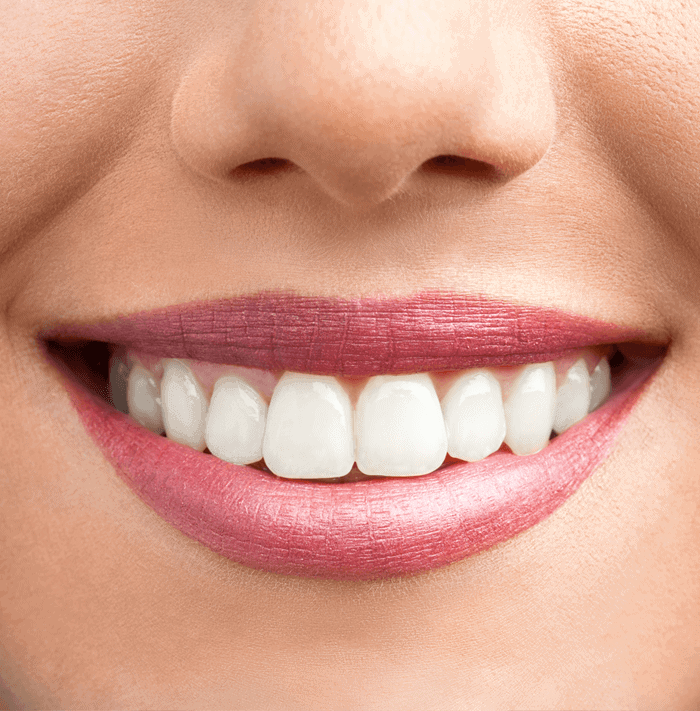
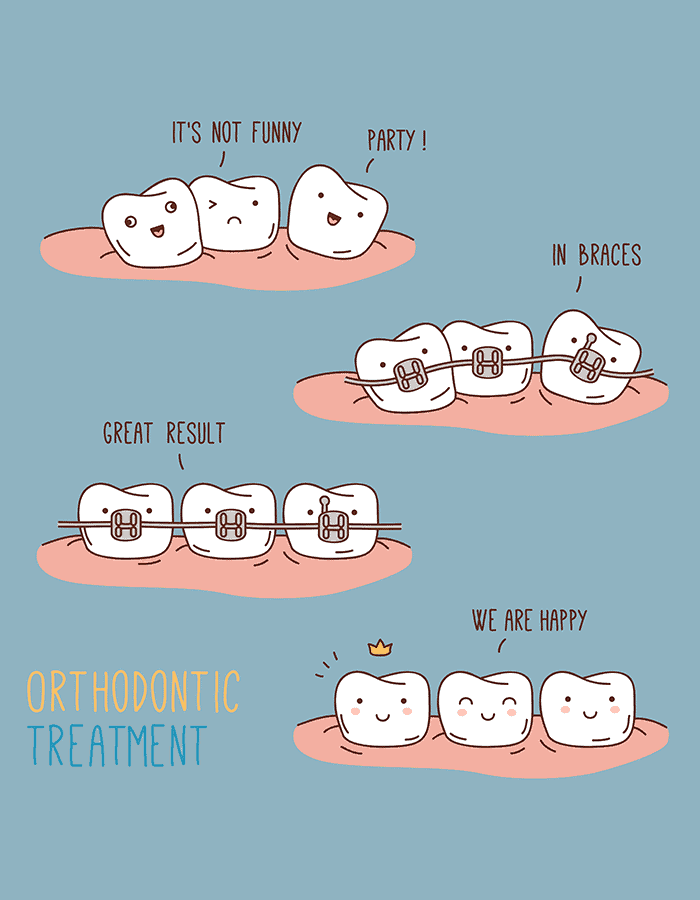
How Orthodontic Treatment Works
Healthy teeth have physiologic tendency to shift with in the surrounding bone. This allows compensation for physiologic wear of teeth in due to constant function. Science of orthodontics takes advantage of this physiologic movement to shift the teeth from bad to good position. Also certain orthodontic myofunctional appliances, when used during growing stage in children, can apply physiologic orthopaedic forces on facial and jaw bones to remodel ( stimulate / restrict or redirect growth) to achieve good facial / jaw proportions whenever needed.
Orthodontic appliances are made of metal, ceramic or plastic. By placing a constant, gentle force in a carefully controlled direction, braces slowly move teeth to the proper position.
Today the braces are more comfortable, effective and faster. They are programmed to deliver optimum orthodontic forces in the right direction so that the teeth achieve their most correct position in the least amount of time. Latest orthodontic appliances and materials are designed to move teeth faster and with more comfort. Even though orthodontic treatment is best done between the ages 10 and 13 years, today, any age is a great age to wear braces.
Duration of Treatment
Orthodontic treatment time varies and can last between one and three years, depending on several factors including age, treatment method, and how minor or severe your case is. A big factor in a successful treatment is you! The more involved and diligent you are, the more efficient your treatment will be. For children, receiving interceptive or early treatment can also help provide a quicker overall treatment time. Before beginning your orthodontic care, your doctor will discuss all of your options and provide an estimate for how long your full treatment may take. Even though orthodontic treatment takes few months to finish, it is the most natural way to have great looking and healthy set of teeth. Please contact our practice to schedule an appointment and learn more about orthodontics and the treatments we provide.

Orthodontic Treatment For Children
The Indian Orthodontic Society and The American Association of Orthodontists recommends that a child should see an orthodontist as early as age seven. At this point, the orthodontist will evaluate whether your child will need orthodontic treatment.
Early treatment (also known as Phase-One) typically begins around age eight or nine (Phase-Two will begin around age 11 or older). The goal of early treatment is to guide the growth of the jaw and correct certain bite problems, such as crossbites. Early treatment also helps to make space for permanent teeth to come in properly, lessening the chance of extractions in the future.
How to tell if your Child may need early Orthodontic Treatment
- Early or late loss of baby teeth (your child should typically start losing teeth around age six, and will have all their permanent teeth in around age 13)
- Difficulty in chewing and/or biting
- Mouth breathing
- Your child continues sucking their thumb after age five
- Speech impediments
- Protruding teeth (the top teeth and the bottom teeth extend away from each other)
- Teeth that don’t come together in a normal manner or even at all
- Shifting of the jaw when your child opens or closes their mouth (functional crossbite)
- Crowded front teeth around age seven or eight


What Causes Orthodontic Problems, and how will early Prevention Benefit my Child?
Orthodontic problems such as crowding of the teeth, too much space between the teeth, jaw growth problems, protruding teeth, and bad bites can be inherited or caused by injury to the mouth, early or late loss of baby teeth, or thumb sucking habits.
Most children have lost all their baby teeth by age 13 and by the end of their teen years the jaw bones will harden and no longer continue to grow. Orthodontic procedures for adults often take more time and can involve tooth extraction and the possibility of oral surgery. As a child, receiving early orthodontic treatment can help prevent the need for complicated orthodontics as an adult, leaving little to no chance of extraction or surgery in most people.
If your child is between the ages of seven and eight and shows signs of needing orthodontic care, or if you have been directed by your family dentist to visit the orthodontist, please contact our practice and schedule an appointment. Our team will provide your child with an initial exam, and discuss with you the best steps to take towards caring for your child’s smile.
Two Phase Treatment
Two-phase orthodontic treatment is a specialized process combining tooth straightening and jaw growth modification in children to achieve beneficial dental and facial changes. The purpose of two-phase treatment is to maximize the opportunity to accomplish the ideal functional and aesthetic result that will remain stable throughout your life.
WHAT IF I POSTPONE THE TREATMENT?
Every child may not require phase 1 treatment. The Orthodontist will tell you if your child requires phase 1 treatment or not. Putting off treatment can result in a need for more invasive treatment with extraction of permanent teeth or jaw surgeries later in life that may have compromised results. Early treatment is most effective for achieving lasting results.

Treatment Phases
Phase 1 Orthodontic Treatment
The goal of Phase-One treatment is to help the jaw develop in a way that will accommodate all of the permanent teeth and improve the way the upper and lower jaws fit together. Children who exhibit early signs of jaw problems or teeth position problems will benefit from phase 1 treatment. It creates a foundation for ideal future dental and facial growth.
Resting Period
In this phase, the remaining permanent teeth are left alone as they erupt. Retaining devices may not be recommended if they would interfere with eruption. It is best to allow the existing permanent teeth some freedom of movement. A successful first phase will have created room for permanent teeth to find an eruption path. Otherwise, they may become impacted or severely displaced.
Phase 2 Orthodontic Treatment
At the end of the first phase of treatment, teeth are not in their final positions. This will be accomplished in the second phase of treatment.
The goal of the second phase is to make sure each tooth has an exact location in the mouth where it is in harmony with the lips, cheeks, tongue, and other teeth. When this equilibrium is established, the teeth will function together properly. Phase two usually involves full upper and lower braces.
Phase 2 or comprehensive orthodontic treatment ideally begins when lest baby teeth are about to be shed or just before the pubertal growth spurt of the child begins. Retainers are worn after this phase to ensure you retain your beautiful smile.
Orthodontic Treatment For Adults
Orthodontic treatment is no longer just for children. In fact, the American Association of Orthodontists states that one in five orthodontic patients is over the age of 21. Many adults are choosing to receive treatment because they understand the importance of maintaining their dental health, and they want to feel better about their appearance. Adults everywhere are taking advantage of the opportunity to receive orthodontic care, and now you can too.
Why Adults Consider Having Orthodontic Treatment
- A bad bite or malocclusion, causing teeth to fit together incorrectly
- Teeth are crowded or spaced apart, possibly leading to tooth decay or gum disease
- Abnormal jaw pain or pressure that is caused by crooked teeth
- Desire for a healthier mouth and a more confident smile
Orthodontic Treatment Options for Adults
For many adults, the thought of having metal braces is enough to discourage them from receiving treatment. However, today’s orthodontic treatment options offer a variety of braces and appliances that are comfortable, aesthetic, and customized to meet your needs. Types of braces include:
- Clear Aligners / Invisalign
- Transparent / ceramic braces
- Lingual (behind the tooth) braces
- Traditional metal braces
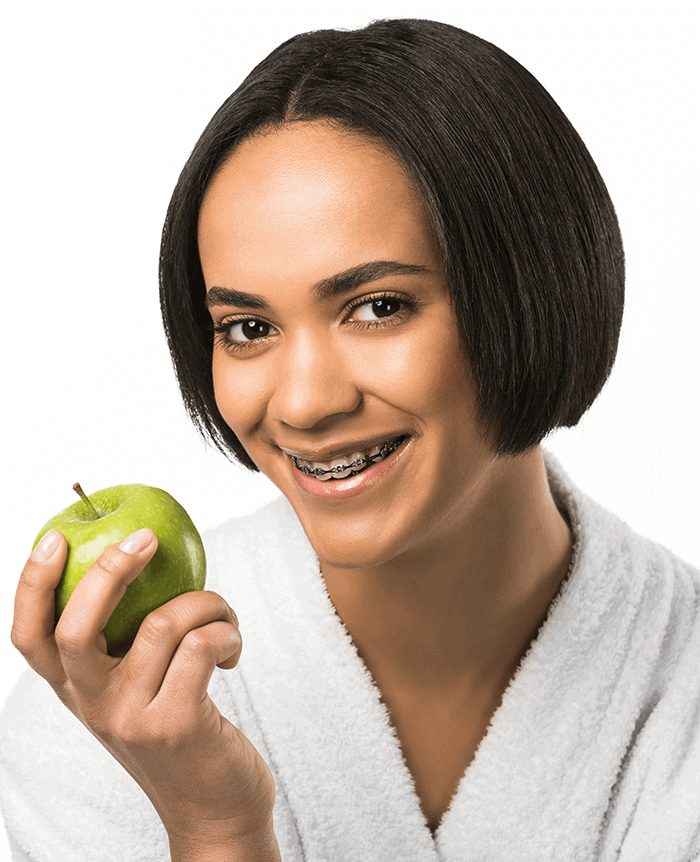

Difference Between Orthodontics for Children and Adults
The main difference to remember when treating adults or children, is that in younger patients the jawbones are still developing and for adults, these bones have stopped growing. Also, the jaw bones are soft in children and teeth movement occurs faster than in adults. Any skeletal jaw related problems may require orthognathic surgery to align the jawbones in adults which could be achieved without surgery in children. Other differences include:
- Gum or bone loss (periodontal disease) – Adults are more likely than children to experience gum recession or even bone loss due to gingivitis or advanced periodontal disease. Patients with straighter teeth are less likely to get gum disease.
- Worn or missing teeth – Over time teeth can become worn down and shift into different positions that can only be corrected with orthodontic care. Missing teeth can cause other teeth to shift and tilt, creating a bad bite and increasing the possibility of gum disease.
- Incomplete orthodontic treatment as a teen – Many adults received some orthodontic treatment as a child or teen, but never completed their treatment. As an adult, they choose to complete their orthodontic treatment to achieve the healthy, beautiful smile they always wanted.
- Our practice also recognizes that adults and children have different needs, and require a different level of attention and care. We will work with you to ensure that you receive the most appropriate treatments, and that your needs are met with understanding and respect from us.
Why Should adults Consider Orthodontic Treatment?
- Straight teeth are healthy teeth – Teeth that are properly aligned are easier to keep clean with flossing and brushing, and may help prevent other health problems.
- A beautiful, straight smile builds confidence – Orthodontic treatment can help boost your self-confidence, giving you a better quality of life and the freedom to smile without holding back!
- Mouths left untreated can get worse – Not receiving orthodontic treatment when it’s needed can create long-term health issues costing you more in the end.
To learn more about the benefits of adult orthodontics, please contact our practice to schedule an appointment. We understand that you have a busy schedule, and we will work with you to make sure each office visit is as convenient as possible

FAQ
WHAT IS ORTHODONTICS?
Orthodontics is a specialized form of dentistry focusing on the diagnosis, prevention, irregularities, abnormalities and treatment of dental and facial abnormalities.
WHO IS AN ORTHODONTIST?
An orthodontist is a dental specialist who has received three years of additional training and experience. Your orthodontist is able to straighten teeth, correct misaligned jaw structure, and improve the function of your teeth and give you an attractive smile.
HOW TO CHOOSE YOUR ORTHODONTIST
Deciding to get braces on is a big decision for you. It is very important for you to choose a good Orthodontist who has adequate knowledge, skills and expertise to diagnose and treat your orthodontic problem correctly.
Incorrectly diagnosed and executed treatment plans can ruin your teeth and face, prolong treatment time and grossly compromise final treatment results.
Here are few tips to choose an orthodontist
- Choose a qualified orthodontist, with an MDS in Orthodontics from a recognized dental institute. These orthodontist receive 3 years special training and pass qualifying examinations to get the MDS degree in Orthodontics.
- Choose an Orthodontist who is board certified : Indian Board of Orthodontics ( IBO) conducts certification examinations every year for qualified orthodontist to assess their clinical work and theoretical knowledge. It is a grueling examination conducted by the board to identify the best clinicians in the country. The Orthodontist who is a Diplomate, Indian Board of Orthodontics, is considered to have developed necessary skill sets to become one of the best in the profession.
- Choose an Orthodontist who has a well equipped orthodontic set up : A resident orthodontist who has his own office has developed an infrastructure which is best suitable to treat an orthodontic patient most effectively. He has well trained staff to assist him and to bring out the best in him. Visiting orthodontists who work at different clinics every day cannot develop an efficient treatment delivery system to achieve best possible results.
- Choose an orthodontist with an efficient maintenance of patient records: Orthodontists are supposed to maintain plaster models, x ray and photographic records of all their patients. The orthodontist who takes pains to maintain these records is more likely to be more methodical in treatment approach. Ask your orthodontist to share with you treatment results of few cases treated by him to understand the quality of results delivered.
- An orthodontist who keeps himself updated by learning new skills and technics and attending speciality conferences is always more informed about technological advancements and newer appliances and technics in the field.
- Take references from friends, colleagues, schoolmates who have undergone braces treatment. Know about the quality of results, duration of treatment and entire approach of an orthodontist.
Do not choose an orthodontist because his treatment fee is less : A good orthodontist knows his worth. He will use quality materials for your braces to give you the best. He will work harder on your smile to mould it perfectly with least discomfort to you in shortest possible time.
WHAT’S THE BEST AGE TO VISIT THE ORTHODONTIST?
If you want to improve the look and feel of your smile, then any age can be a great age to see the orthodontist. The Indian orthodontic Society and American Association of Orthodontists recommends that children first visit an orthodontist around the age of seven.
The Orthodontist will then evaluate the child’s teeth and facial structure and identify any abnormal developmental conditions which may require an early treatment. If everything is fine, the child is scheduled for next orthodontic evaluation at the age of 10 ½ years during which most of the treatment decisions are taken and orthodontic treatment may be started. However, if you have missed this important age for orthodontic evaluation, It can very well be done at a later age.
Although the Orthodontic treatment is best done during growing years of a child, it is not exclusive to children and teens, with about one in every five orthodontic patients being over the age of 21. Whether you’re considering treatment for yourself or for a child, any time is a good time to visit the orthodontist.
HOW CAN I TAKE CARE OF MY TEETH IF I’M WEARING BRACES ?
ALWAYS remember to brush your teeth after every meal and floss at least once a day.
Make sure to use toothpaste that contains fluoride, and ask your orthodontist or family dentist if you need a fluoride rinse. This will help prevent cavities!
During your treatment, try to avoid foods with a lot of sugar (sugar increases the amount of bacteria that grows in your mouth, causing more plaque and possibly cavities).
Avoid sticky and chewy foods (caramel, chewing gum, gummy bears), hard foods (hard candy, nuts, ice cubes), or any foods that could possibly get stuck in your braces ( popcorns, nuts, chocolates etc.).
Make sure you visit your family dentist regularly for professional cleaning and cavity check.
HOW CAN I TAKE CARE OF MY RETAINERS?
If you take out your retainer to eat, make sure you brush your teeth, floss, and remember to keep it safe in its container so that it does not get lost or broken.
Keep your retainer clean by brushing it gently with a toothbrush and mild soap. You may also soak it in denture cleaner as instructed by your orthodontist. Do not put your retainer in boiling water or in the dishwasher.
WHAT ARE BRACES?
Braces are used by your orthodontist to deliver gentle forces to teeth to help them move to a better position, which will improve the look and feel of your smile. There are several different types of braces to choose from, including:
Clear braces Ceramic braces Gold braces Lingual braces Self-ligating braces Invisible braces Traditional metal braces
IF I GET BRACES, HOW LONG DO I HAVE TO WEAR THEM?
The amount of time spent in braces will vary depending on severity of orthodontic problem and age of the individual patient, because every smile responds differently to treatment. Treatment times can take anywhere between six and 30 months, but most standard treatments take about 18 months.
DO BRACES HURT?
Braces do not often hurt though you may feel a small amount of discomfort for a couple days as your teeth, gums, cheeks, and mouth get used to your new braces.
DO I NEED TO BRUSH MY TEETH MORE OFTEN IF I HAVE BRACES?
With braces, you should brush your teeth at least three times a day to keep your teeth, gums, and mouth healthy and clean. Brushing regularly will help remove any food that may be caught between the braces. You should also floss daily to get in between your braces where your brush isn’t able to reach. Your orthodontist can show you how to properly brush and floss once your braces are placed.
IF I HAVE BRACES, DO I STILL NEED DENTAL CHECKUPS EVERY SIX MONTHS?
Yes! In fact, it’s even more important that patients receiving orthodontic treatment visit their dentist regularly. With braces, food may be caught in places that your toothbrush can’t reach. This causes bacteria to build up that can lead to cavities, gingivitis, and gum disease. Your dentist will work closely with your orthodontist to make sure that your teeth stay clean and healthy while wearing braces.
WILL MY BRACES INTERFERE WITH MY SCHOOL ACTIVITIES LIKE SPORTS, PLAYING AN INSTRUMENT, OR SINGING
Playing an instrument or a contact sport may require some adjustment when you first get your braces, but wearing braces will not stop you from participating in any of your school activities. If you play a contact sport, it is recommended that you wear a mouthguard to protect your braces or appliance.
HOW DO I SCHEDULE MY NEXT APPOINTMENT?
Simply call our practice! Our front desk staff will be happy to help schedule your next appointment at your convenience. If you are a new patient or have been referred to our practice, please let us know and we will provide you with all of the information you need.
Metal Braces
- Traditional metal braces – do not have door inbuilt wire locking mechanism , hence requires additional ligature wire or elastic o ring to secure wire into bracket slot.
- Self Ligating metal braces – these have in built wire locking mechanism. No additional ligature wires or o rings required. Hence easier to keep clean.
- ADVANTAGE – Easier to keep clean and maintain. Easier to apply orthodontic forces. Does not impede speech and eating.
- DISADVANTAGE – visible to others so some people, especially adults don’t prefer them
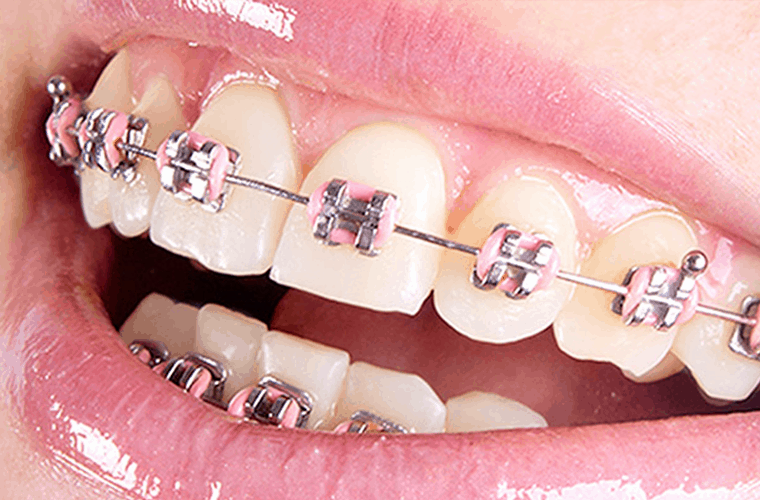
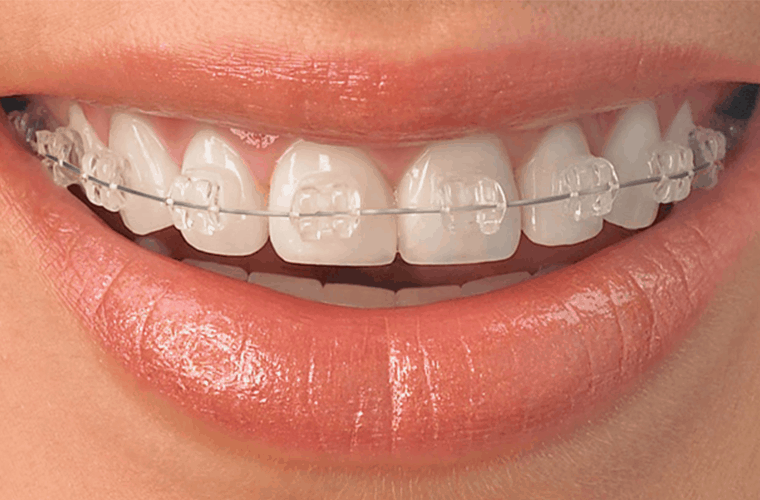
II. Ceramic / Transparent Braces
- These are fixed on the outer surface of teeth
- ADVANTAGE – Easier to keep clean and maintain. Easier to apply orthodontic forces. Does not impede speech and eating. Almost invisible as they blend with teeth colour .
- DISADVANTAGE – These are not completely invisible. wires may be visible sometimes.
- TYPES
- 1. Traditional ceramic braces – do not have door inbuilt wire locking mechanism , hence requires additional ligature wire or elastic o ring to secure wire into bracket slot.
- 2. Self ligating ceramic braces – these have in built wire locking mechanism. No additional ligature wires or o rings required. Hence easier to keep clean.
III. Lingual / Invisible braces
- These are fixed on inside / inner surface of teeth facing the tongue
- ADVANTAGE – These are completely invisible
- DISADVANTAGE – Difficult to keep clean. Irritation to tongue . speech difficulty . Difficult to apply orthodontic forces.
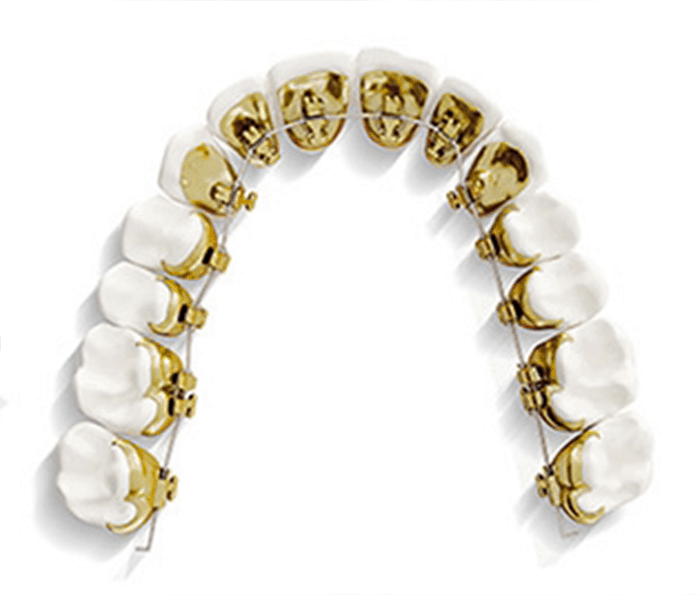
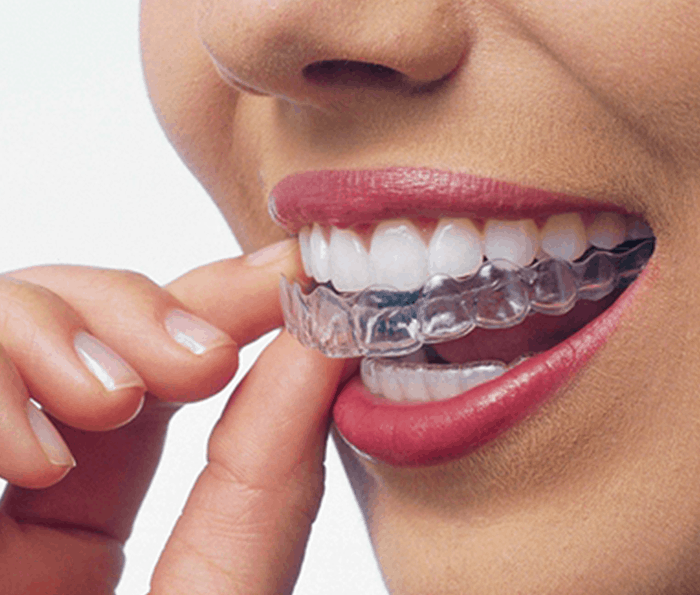
V. Clear Aligners
Clear Aligners are a series of invisible, removable, and comfortable aligners to straighten your teeth. And, no one can tell you are wearing aligner because it’s invisible! Not only are the aligners invisible, they are removable, so you can eat and drink what you want while in treatment, plus brushing and flossing are less of a hassle. The aligners are comfortable and have no metal to cause mouth abrasions during treatment.
-
ADVANTAGE
- Completely invisible
- Removable, hence can be removed while eating food and brushing teeth
-
DISADVANTAGE
- Technic sensitive
- Requires excellent compliance
- Challenges during case finishing
A. Myofunctional Appliances
Myofunctional appliances are specific orthopaedic appliances for facial skeleton to bring about desirable changes in position, shape and size of jaw bones in a growing child. For example, if a child of 11 years has got small lower jaw giving him an appearance of bird face, a custom fabricated removable myofunctional appliance called an activator or a twin block can be given to child to wear on teeth and jaws, which delivers natural , mild and painless forces to the growing lower jaw through jaw muscles to make it grow more and in proportion to the upper jaw.
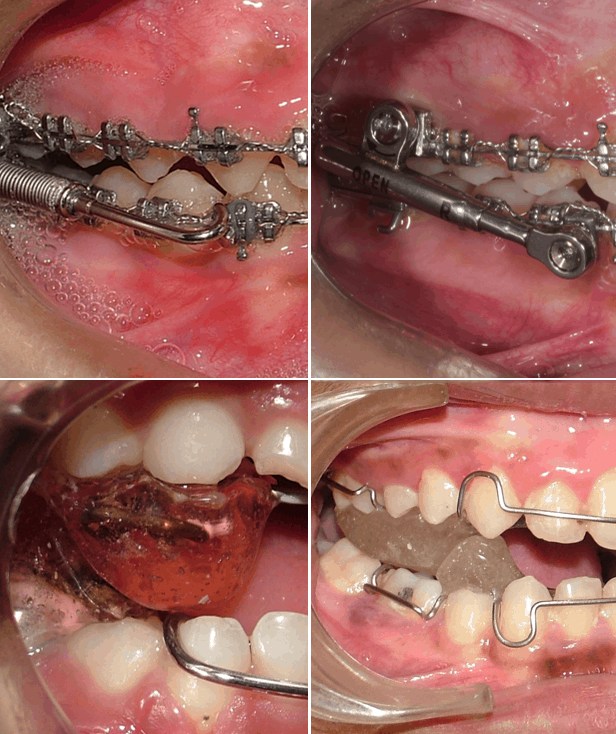
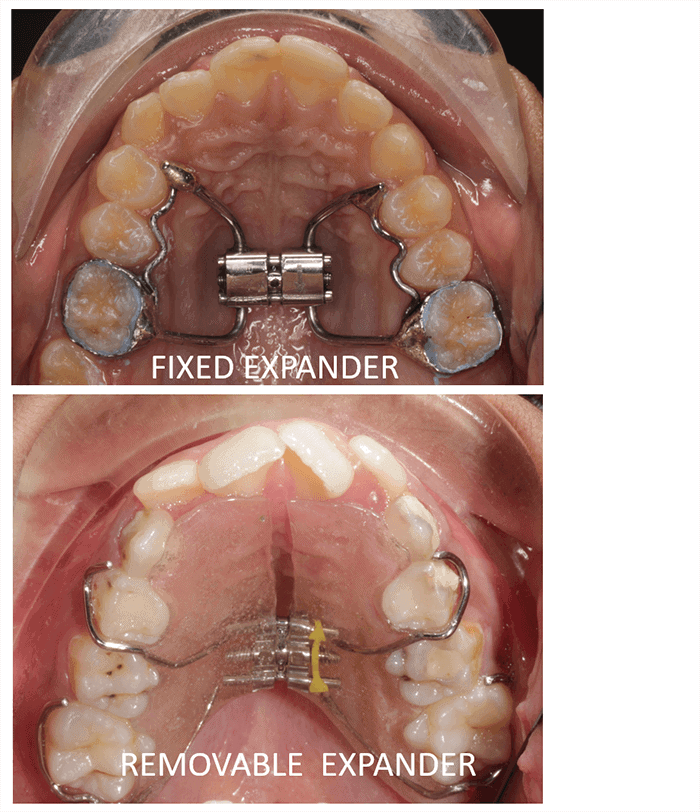
Other Orthodontic Appliances
REMOVABLE
These appliances can be worn and removed by the patient easily and should be used for specified number of hours as instructed by the orthodontist.
FIXED
Fixed myofunctional appliances are fixed directly to the teeth or to fixed braces and can not be removed by the patient. These are used when the child is about to finish his growth spurt and has only few months remaining to complete his/ her growth. These are can also used in non cooperative children who do not wear removable myofunctional appliances as per instructions.
B. TADs
Temporary Anchorage Devices ( TADs) are small miniscrews made of titanium alloy which are painlessly fixed to jaw bone or bone around the teeth and are used to take support to apply orthodontic forces to carry out certain tooth movements which are difficult to accomplish with routine braces. These miniscrews are small, mostly not visible , biocompatible , painless and do not interfere with any mouth functions. These miniscrews are removed once their role is accomplished.
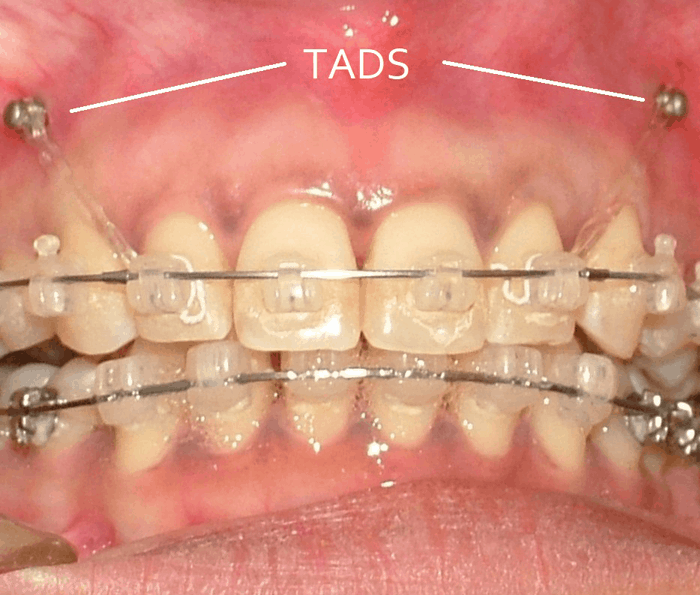
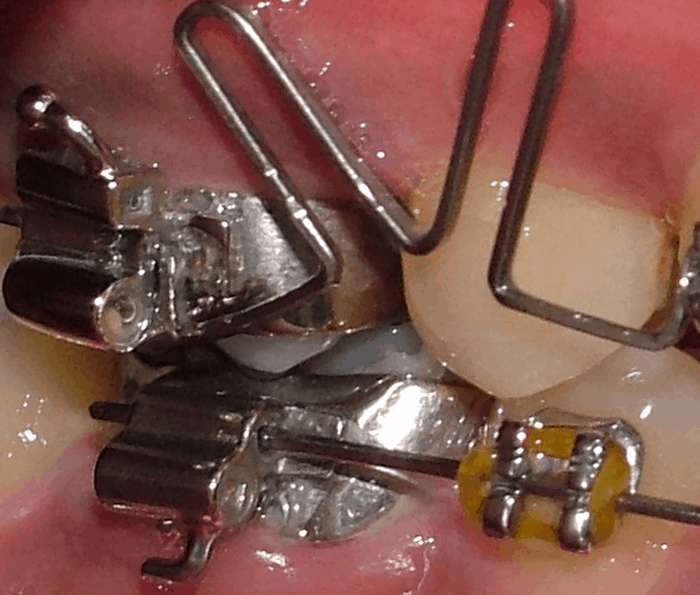
C. Molar Distalizers
These appliances are mostly used in the upper jaw to push the upper molar teeth behind to generate space which can be utilized to correct crowding or protrusion of front teeth. In addition to generating additional space it also improves the functional relationship of upper and lower molar teeth.
D. Headgears
Headgears are external appliances which are used to deliver orthodontic / orthopaedic forces to teeth /jaw bones. Headgears take support of external surface of skull bone / neck to apply desirable forces. Headgears generally are used for a specified number of hours per day and can be removed / worn easily by the patient.
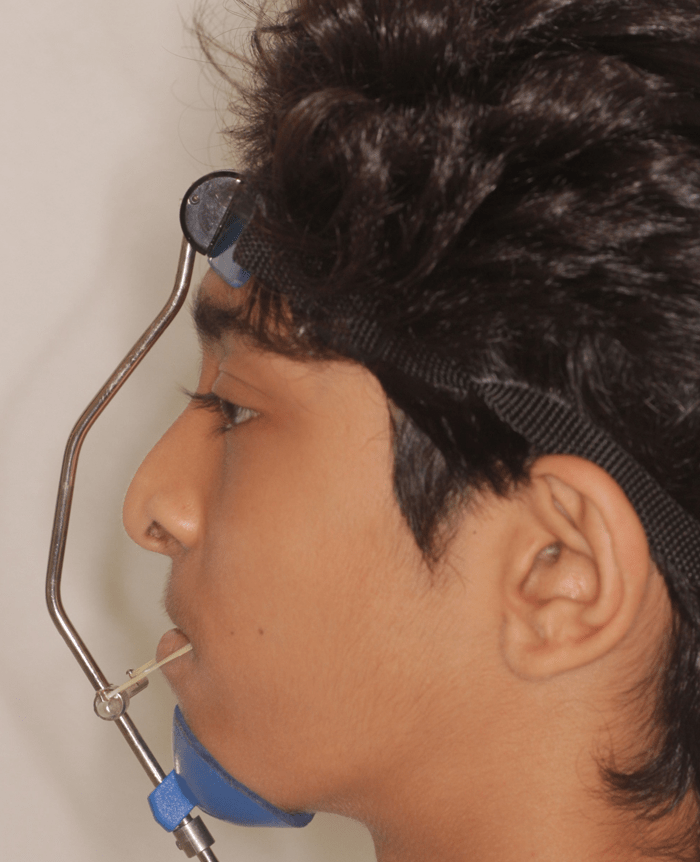
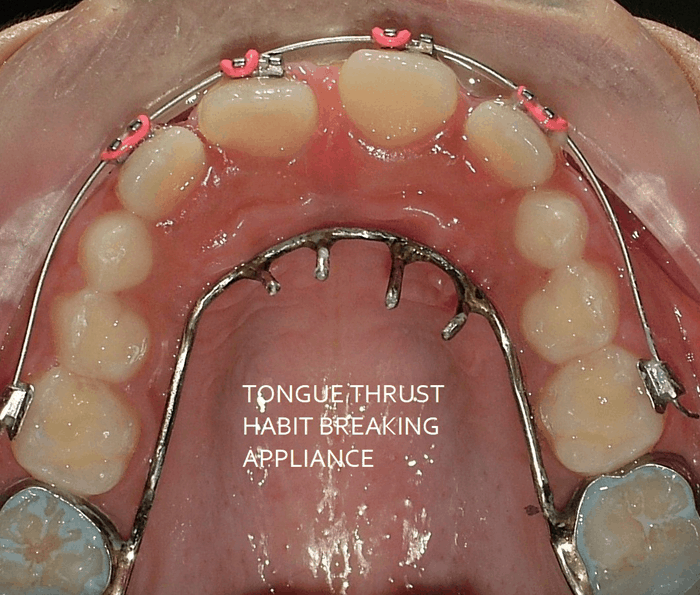
E. Habit Breaking Appliances
Habit breaking appliances are specific, custom fabricated appliances which may be removable or fixed and are mostly worn inside the mouth to help a child to discontinue a detrimental thumb or finger sucking habit or to improve a bad tongue posture which may cause undesirable teeth position and affect growth of facial bones. These appliances are worn until the child completely stops a particular habit. These appliances can be used separately or along with fixed braces.
F. Space Maintainers
A milk tooth serves a very important function of preserving space for the permanent tooth which takes it’s place. Sometimes an early loss of a milk tooth causes drifting of adjoining milk / permanent teeth and space required for the subsequent permanent tooth reduces / closes completely, causing it to stay impacted inside the bone or erupt in an awkward position. Hence, if a milk tooth sheds or has to be removed before the permanent tooth below is formed and is ready to erupt, a SPACE MAINTAINER appliance is given which holds the space required for the permanent tooth till it is ready to erupt in mouth.
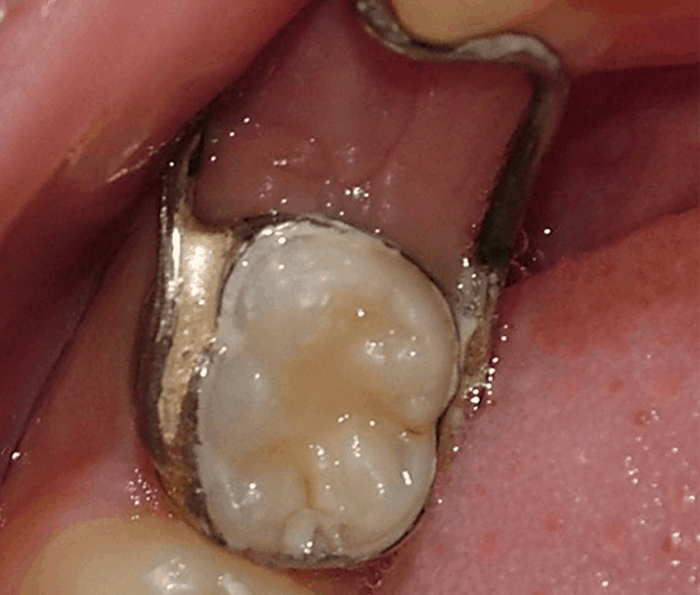
Dentofacial Orthopaedics / Facial Growth Modification
Dentofacial orthopedics involves the guidance of facial growth and development, which occurs largely during childhood. It is the process of “normalizing” the growth and position of a child’s jaws and minimizing any imbalances of the face and jaws. Children are often the best candidates for dentofacial orthopaedics.
In this, the orthodontist would use certain appliances to correct / redirect the growth of jaw bones which may be growing disproportionately. Therefore, it is important to screen children around 9 years of age to determine if early (Phase I) treatment is needed to take advantage of their jaw growth. 9-11 years of age is a period of significant growth in most children and it is important to take advantage of that growth in children who have disproportionately growing jaws.
Once the pubertal growth is over these jaw disproportions are difficult to correct without jaw surgeries. Hence Dentofacial Orthopaedics is the only non surgical intervention to improve the jaw proportions.
The Orthodontist can monitor your child’s jaw growth to determine if dentofacial orthopaedics is indicated and the most effective time for it.
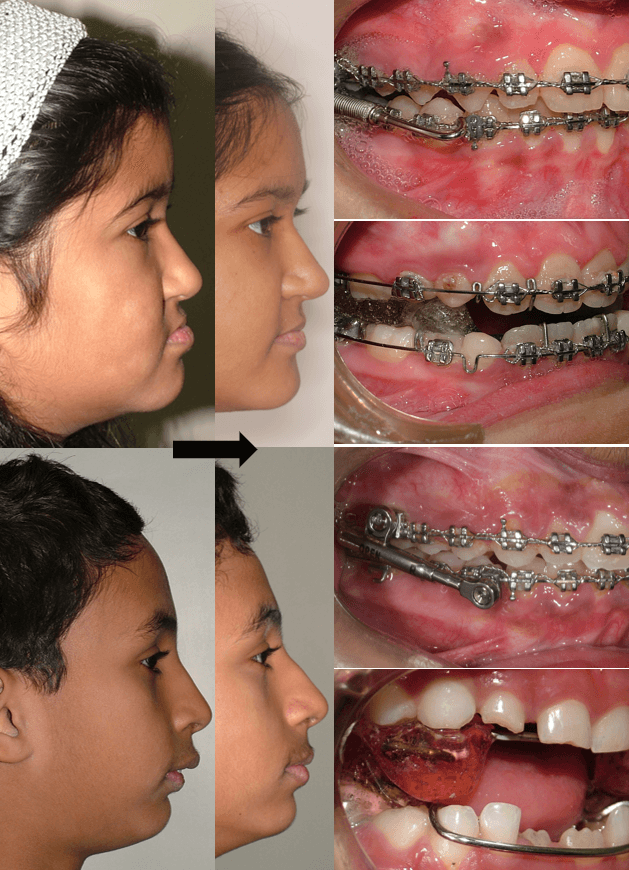
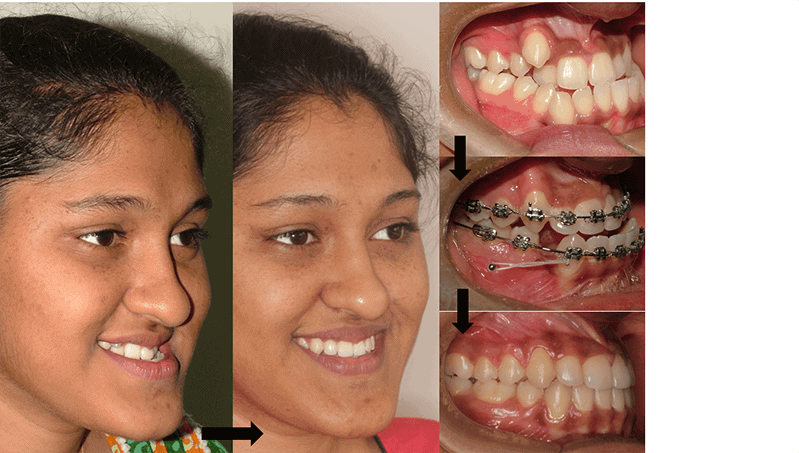
Non Surgical Skeletal Corrections
Skeletal disproportion between maxillary and mandibular jaws leads to several types of orthodontic problems. To correct these problems Orthodontic treatment along with jaw surgery is normally required. But with introduction of skeletal anchorage and better understanding of facial esthetics, many such problems can be corrected just with orthodontics. Generally these cases are mild to moderate skeletal issues which have to fit into certain criteria of severity.
Please ask us if you need to know more about how you can avoid surgeries and yet get a perfect set of teeth.
Here is a case which required surgery to correct her dental crossbite but was resolved without surgery by careful treatment planning.
Orthognathic Surgery
Orthognathic surgery, is treatment of choice in individuals who have severe jaw disproportions due to abnormal jaw growth. Abnormal jaw growth may be due to excessive growth or deficient growth leading to smaller or larger jaw. Along with surgery braces treatment is always required to correct the teeth positions associated with abnormal jaws. Immaculate treatment planning and communication between the orthodontist and surgeon is required for best possible treatment outcomes.
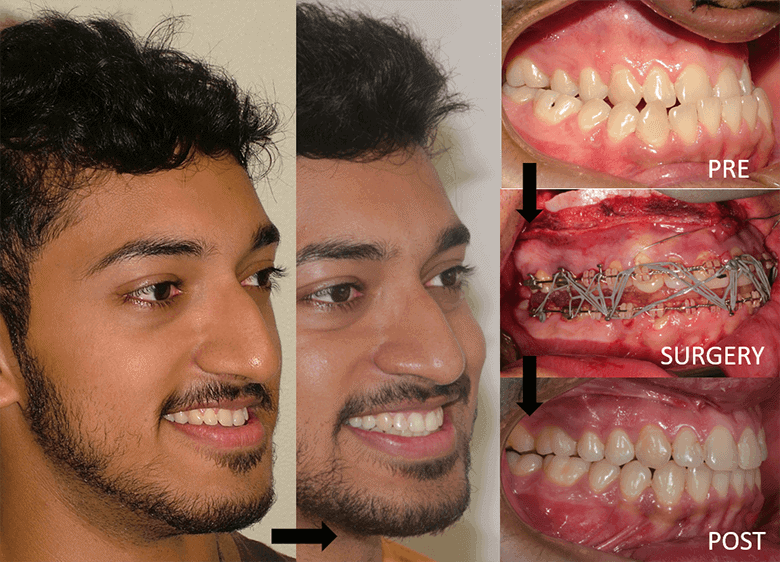
When Might Surgical Orthodontics be Needed?
Surgical orthodontics may be used to treat adults with improper bites or other aesthetic concerns. Typically, jaw growth stops by age 16 in females and 18 in males. In order to receive orthognathic surgery, the jaw must be done growing. The need for surgical orthodontics occurs when the jaws do not line up correctly, and a proper bite cannot be achieved with orthodontic treatment alone. Orthognathic surgery will help properly align the jaw, and orthodontic braces will then be used to move the teeth into their proper position.
How do i Know if i need Orthognathic Surgery?
Your orthodontist can tell you if orthognathic surgery is needed as part of your treatment. Depending on the severity of your case and the alignment of your jaw, you may or may not need surgery.
Pre Surgical Orthodontics
Before the orthognathic surgery is undertaken, most cases require braces treatment to improve the position of teeth to aid surgical jaw correction. Usually presurgical orthodontics lasts for about 6 months to a year. In selected cases, presurgical orthodontics can be avoided altogether and surgery can be performed first followed by braces to correct teeth position.
How Does Orthognathic Surgery Work?
An oral and maxillofacial surgeon will perform your orthognathic surgery, and the surgery will take place in a hospital. Orthognathic surgery can take several hours depending on each individual case. Once the surgery is complete, you will have about a two-week rest period. Since orthognathic surgery is a major treatment, we recommend that you schedule some time away from work and school during the healing process.
Post Surgical Orthodontics
After your jaw has healed, your orthodontist will once again “fine-tune” your bite. After surgery, you will have to wear braces, and most braces are removed within six to 12 months following surgery. After your braces are removed, you will wear a retainer to help maintain your new smile.
What Are The Risks Associated With Orthognathic Surgery?
As with any major medical surgery, there may be certain risks of having orthognathic surgery. However, the process of orthognathic surgery however is not new, and it has been performed for many years in practices and hospitals. If you’re concerned about an upcoming treatment with orthognathic surgery, please contact our practice and let us know. We are happy to answer any questions that you may have, and provide you with any additional information. Your comfort is important to us.
What Are The Rewards Of Having Orthognathic Surgery?
For many patients, the most important reward of having orthognathic surgery is achieving well proportioned jaws and a beautiful, healthy smile that lasts a lifetime.
Common Treatments
Orthodontics can bring about a positive change in your smile and the face in the most natural way. It not only brings about an esthetic improvement in your smile and the face but also improves health and longevity of the dentition. It does give you a psychologic boost which improves your self esteem and confidence opening many doors in the journey called “LIFE”. Following are few examples.
A. Crowded Teeth
Crowded teeth can look awful and are difficult to clean leading to dental decay and periodontal problems causing loss of teeth early in life. Timely correction of crowded teeth with orthodontics improves your smile and gives you healthier set of teeth which are much easier to clean.
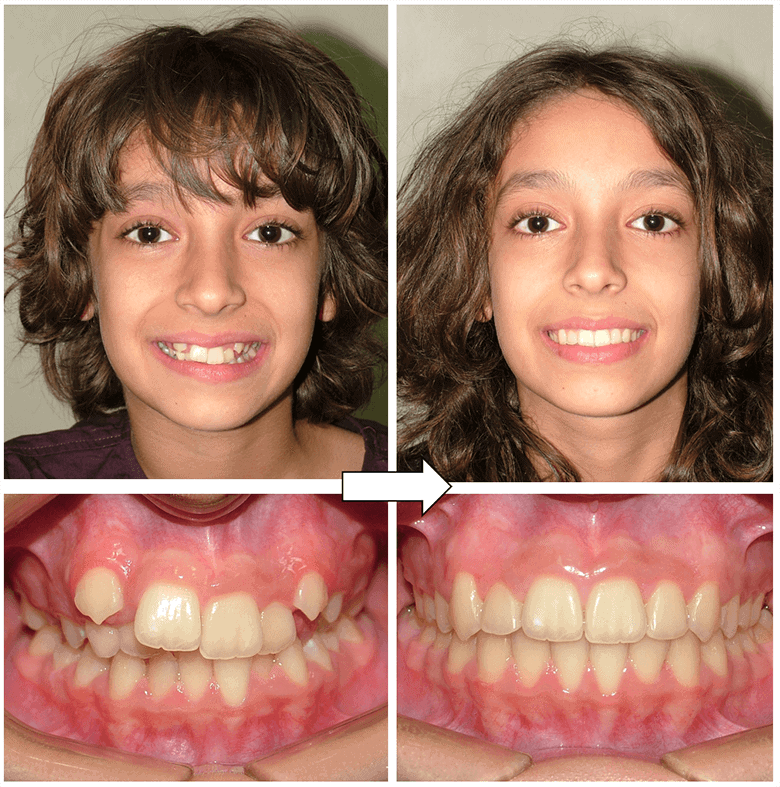
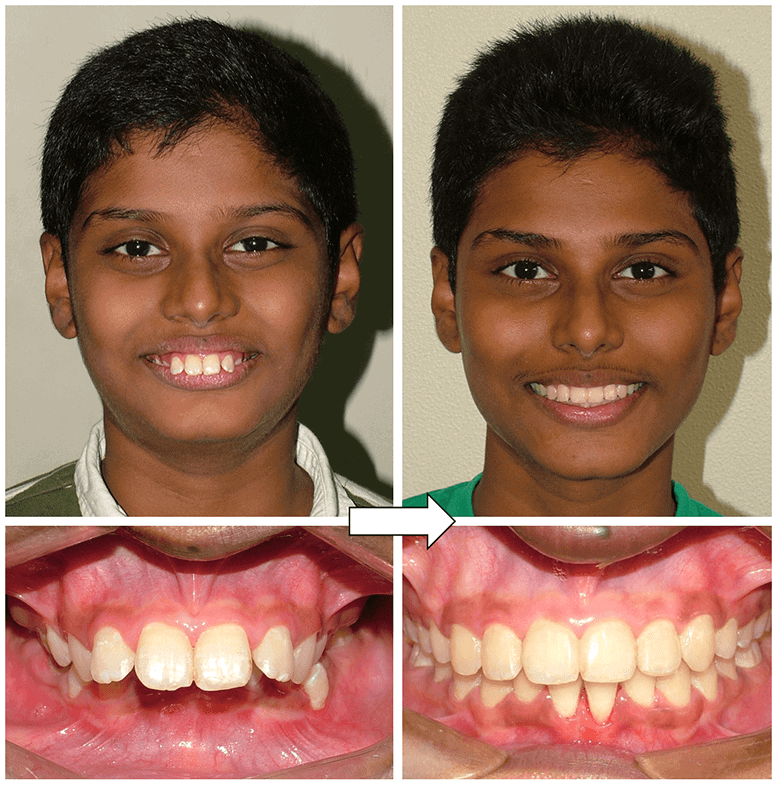
B. Protruded Teeth
Forwardly placed teeth not only look bad but also are more prone to trauma. They can cause difficulty in lip closure , drying of mouth and speech problems. Orthodontics can correct teeth protrusion easily and future dental and facial problems can be avoided with timely treatment of protruded teeth.
C. Spaced Teeth
Spacing in teeth can be due to small size teeth, teeth protrusion, missing teeth or unnatural migration of teeth. Spaced teeth look ugly and can cause speech difficulty. Correct orthodontic diagnosis and treatment planning is required to achieve satisfactory result and healthy occlusion.
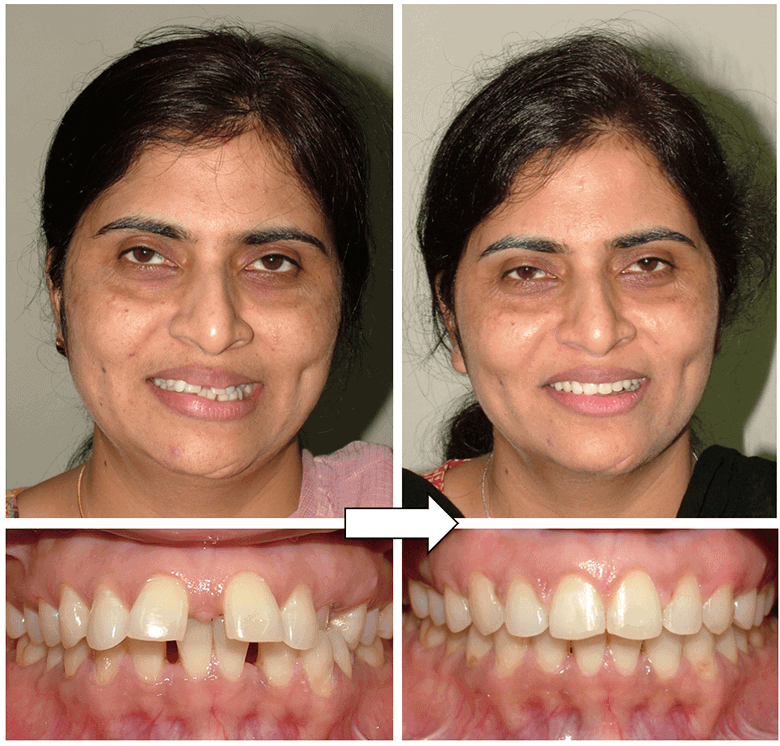
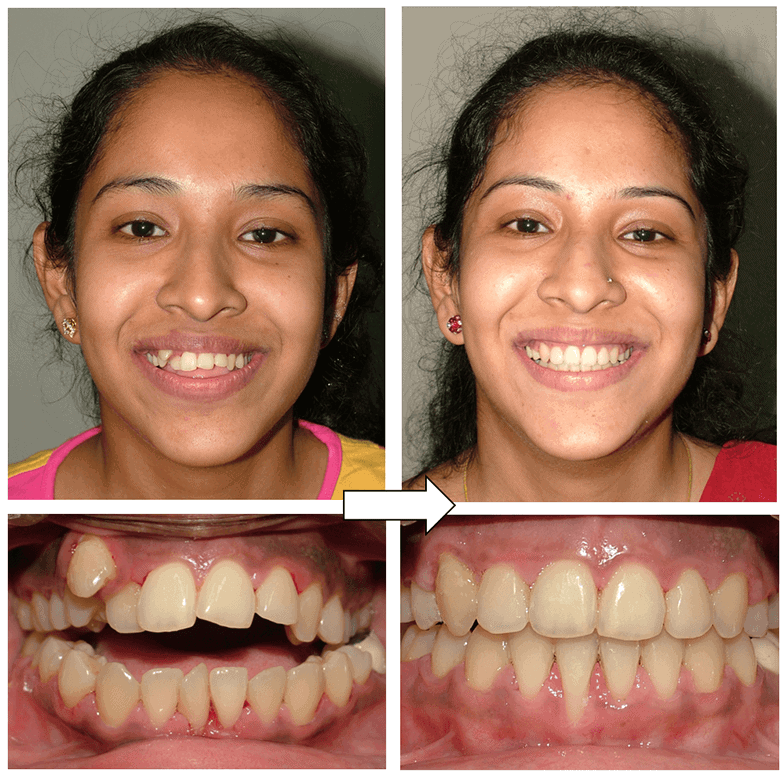
D. Open Bite
Open bites are usually caused by finger sucking habit or improperly growing facial skeleton. Diagnosis has to be done as early as possible. Finger sucking habits should be stopped immediately and facial growth should be normalized. Skeletal open bites may require surgery if orthodontic treatment is delayed or oral habits continue.
F. Deep Bite
Deep bites usually are developmental problems and should be treated early with orthodontics. Persistent deep bites can lead to traumatic occlusion, TMJ problems and unnatural teeth wear.
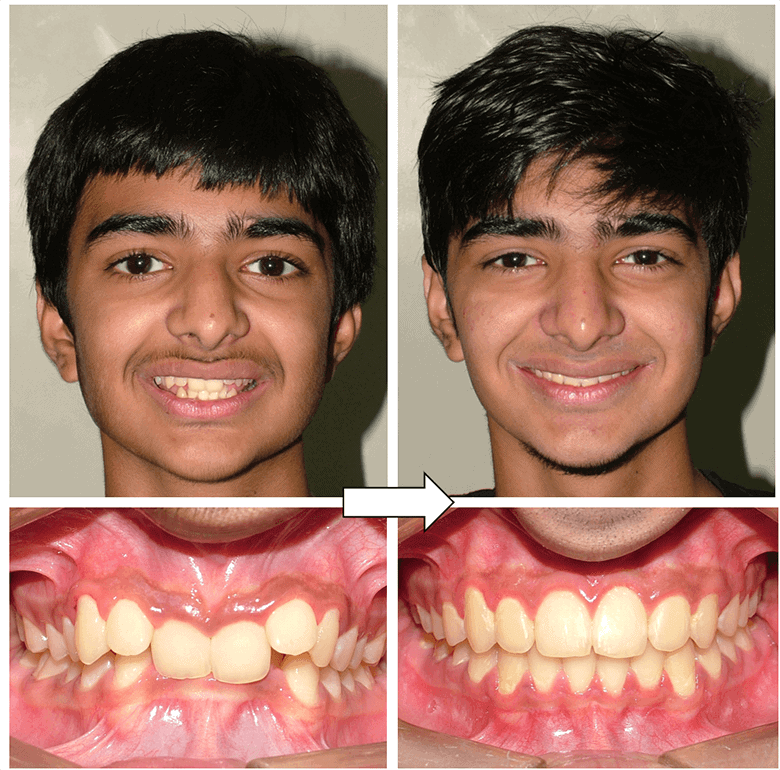
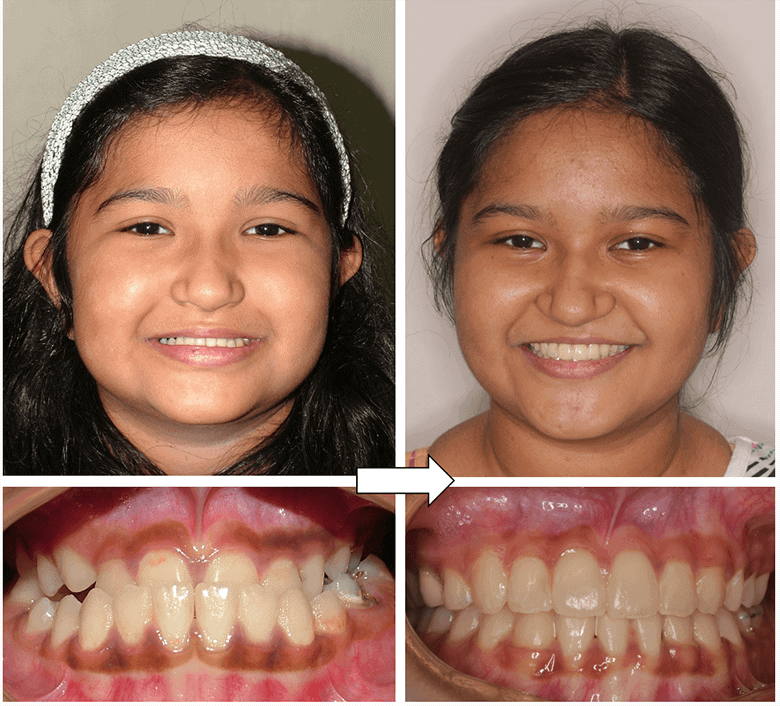
G. CrossBite
Crossbites are again developmental in origin or may be caused by finger sucking habits. They may alter the chewing path of jaw causing imbalance in jaw musculature leading to TMJ problems. It may also lead to improper bite and may affect facial esthetics. Crossbites should be detected and corrected early in life to avoid abnormal facial growth and traumatic occlusion.

